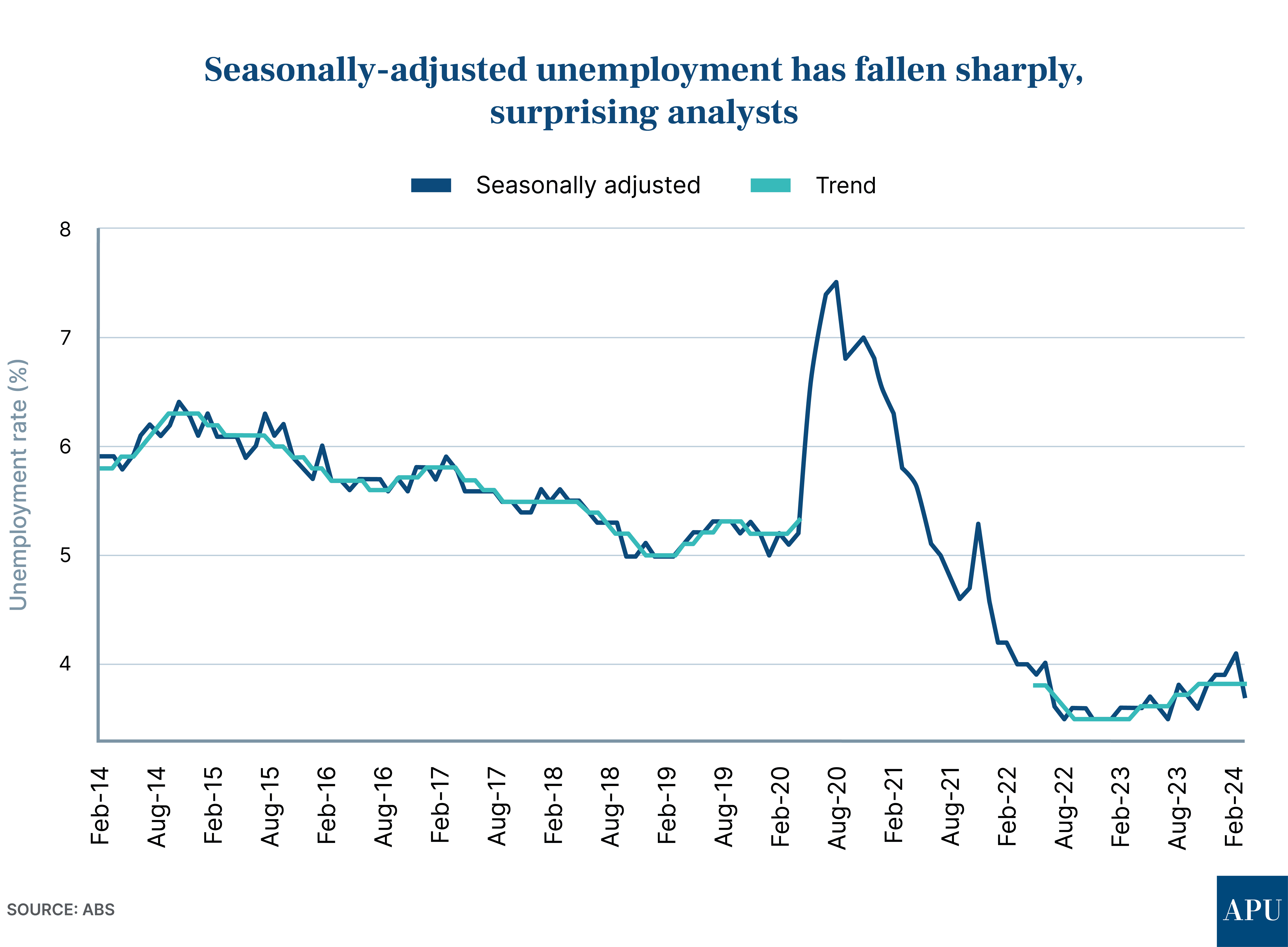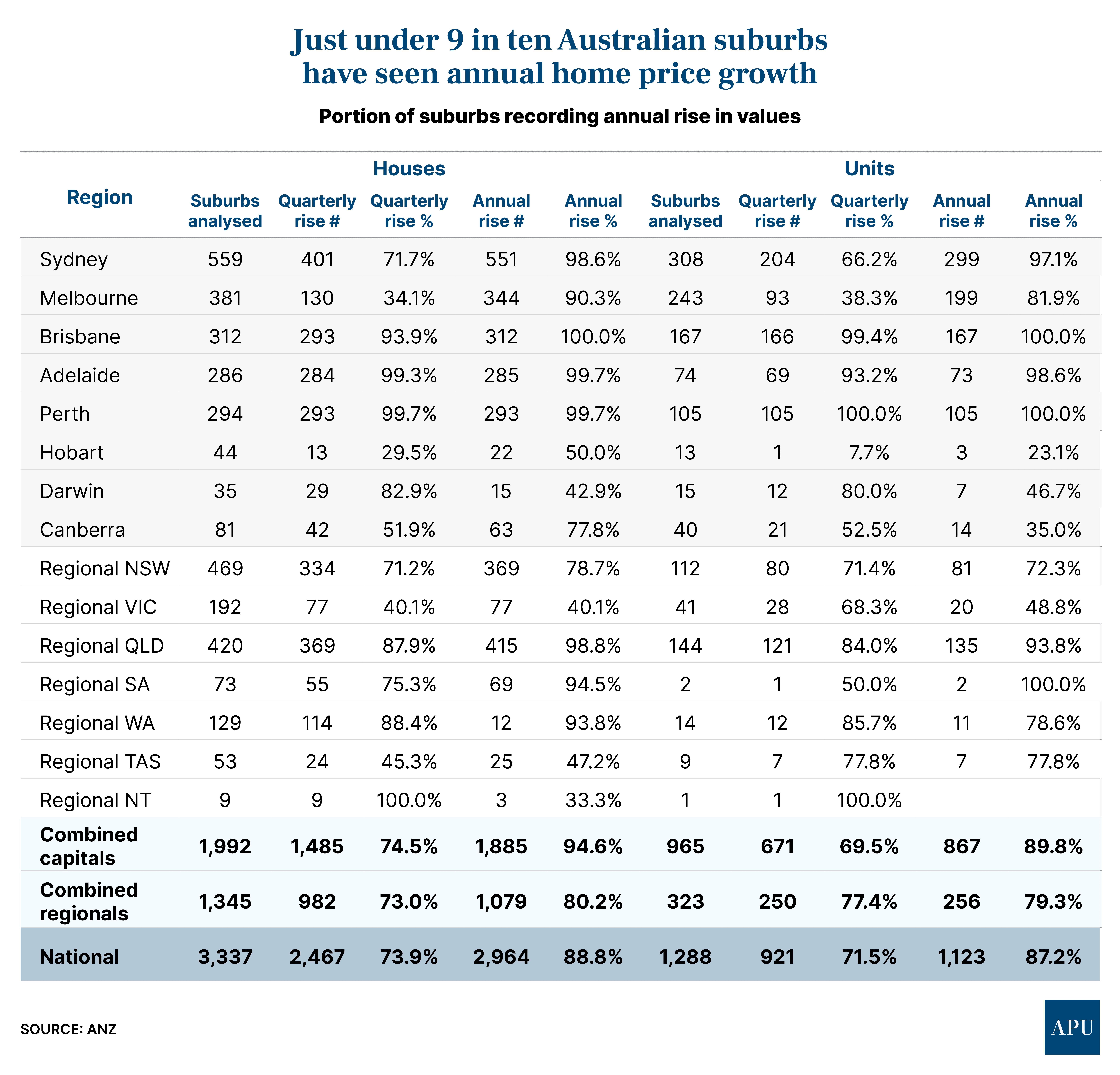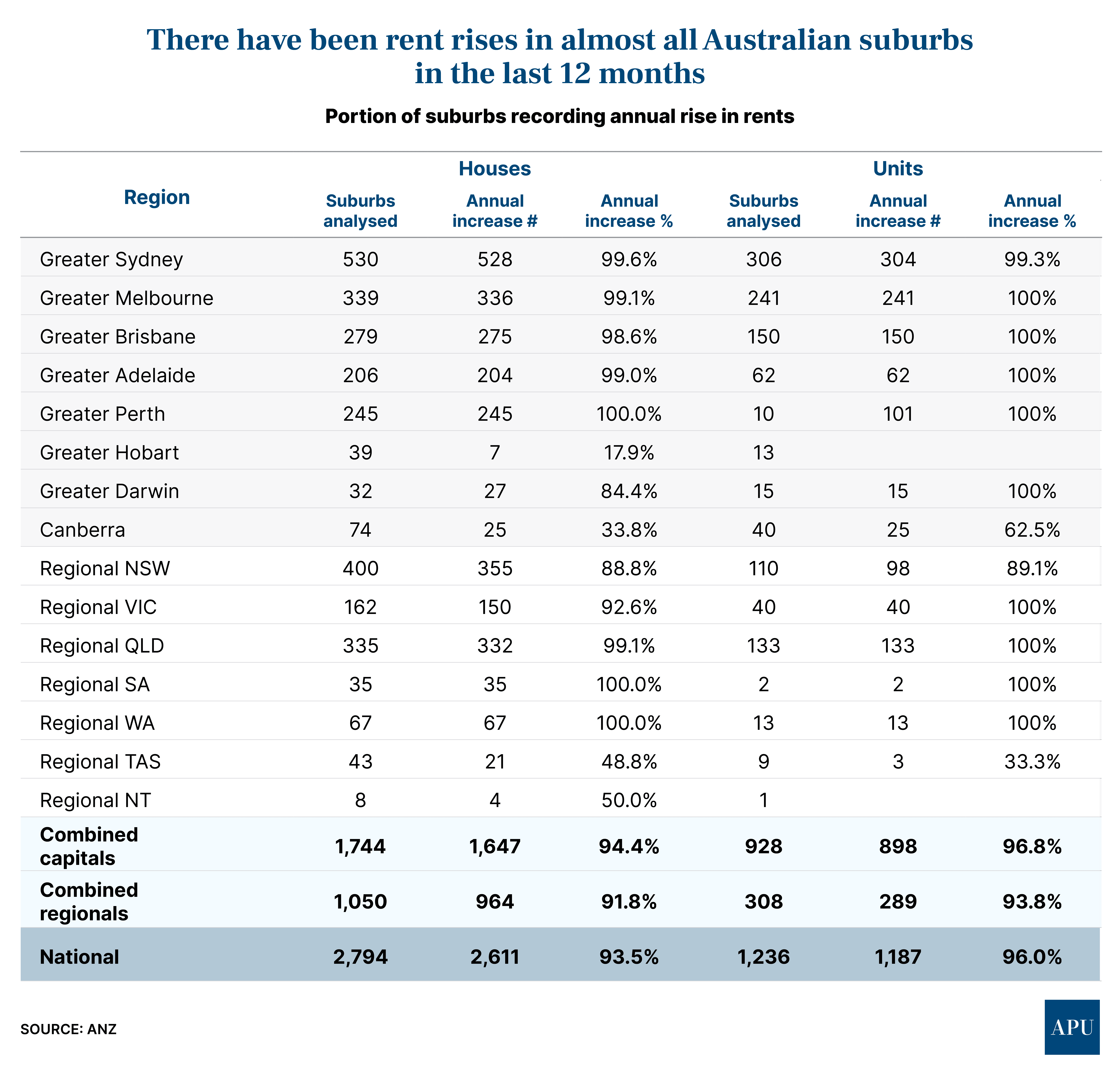Features > Property News & Insights > Market updates
Even if the RBA doesn’t cut rates, don't expect home prices to fall

KEY POINTS
- Strong job growth has seen a surprise fall in unemployment to 3.7%
- The strong labour market data has dampened hopes of RBA rate cuts before late this year
- Figures also show Australia’s population is growing at its fastest rate in 70 years, helping to drive up house prices and rents, even in a high-interest rate climate
Hopes for interest rate relief any time soon for households struggling with high mortgage repayments appear to have been dashed, following the release of unexpectedly strong employment data.
The figures demonstrate the underlying strength of the Australian economy and call into question the Reserve Bank of Australia’s efforts to slow demand.
New population data also continues to show strong growth, fuelled by high immigration, which is likely to exacerbate the housing shortage and continue to drive up home prices and rents.
Strong employment
Seasonally adjusted data from the Australian Bureau of Statistics has defied market predictions, showing unemployment fell almost half a per cent to 3.7% in February, with the creation of 116,500 new jobs.
It’s the highest monthly job growth since July 2000, with 78,200 full-time positions and 38,300 part-time roles being created.

Treasurer Jim Chalmers welcomed the figures saying they were “remarkable”, while EY senior economist Paula Gadsby says they’re “particularly stunning”, and evidence of the strength of the labour market.
“At a time when people are doing it tough in so many ways, to have people have a job is possibly one of the most important things of all,” observed Employment Minister Tony Burke.
While many commentators have pointed to volatility in monthly employment data, Oxford Economics Australia’s Ben Udy believes the Reserve Bank is likely to be alarmed by the figures.
“These data clearly challenge the view that monetary policy is providing enough of a drag on the economy to bring down wage growth and inflation,” he says.
The employment data release came just two days after the RBA decided to leave the cash rate on hold at 4.35%.
The central bank has previously indicated it believes unemployment would need to rise, not fall, for it to be in a position to even consider interest rate cuts.
“There is still a lot of strength out there in the economy that will make the Reserve Bank a little too nervous to be cutting rates anytime soon,” says former Treasury economist Chris Richardson.
ANZ Bank Senior Economist Blair Chapman says any hope of the RBA cutting rates before November this year has now “probably been pushed back.”
That’s obviously a blow to households with a mortgage.
However, for those looking to get onto the property ladder and hoping that home prices may ease as higher interest rates continue for longer, you’re likely to be disappointed.
High population growth
The employment data came as the ABS also released new figures, showing population growth has reached 2.5%.
That’s the highest rate since 1952 when the post-war immigration boom was in full swing.

The rate was driven by net overseas migration of 548,800 people in the 12 months to the 30th of September last year.
Some analysts say these arrivals are mainly international students and temporary workers and claim the post-pandemic spike in arrivals won’t last, as the government cracks down on rejecting visa applications for “non-genuine” students.
But others, like Damian Collins from Perth-based Momentum Wealth, say even if the numbers ease, there are already serious implications for housing.
“At 2.5 persons per household that's 264,000 more dwellings needed and we are completing close to 90,000 short of that number,” he says.
“Prices and rents across most capital cities are heading in one direction, and that's up…”
Home prices
That assessment of the outlook for home prices is backed up by stunning new data from CoreLogic which shows that 9 out of every ten Australian suburbs saw home prices and rent increases over the past 12 months.
This is up from 52.9% of markets in July 2023, and 39.1% that recorded positive annual growth in February 2023.

“The broad-based capital gains seen over the past year reflect the ongoing imbalance between housing supply and demand, which has helped to counteract the less favourable market and affordability conditions,” says CoreLogic Economist Kaytlin Ezzy.
“Despite three rate hikes, worsening affordability, and the rising cost of living, the increasingly entrenched undersupply in housing stock, and above average demand thanks to strong net migration, has helped push values higher.”
CoreLogic also found that 94.2% of the 4,030 house and unit markets analysed recorded an annual rent rise, while nearly 40% saw rental values rise by 10% or more.

The takeaway
The Federal government insists population growth will “moderate” as a result of changes to the “integrity” of the migration system, saying the latest ABS numbers don’t reflect the changes that were made last year.
But even if population growth slows, there’s no getting away from the fact that there is already a chronic housing shortage, and the rules of supply and demand indicate home values and rents are unlikely to fall.
As for the Reserve Bank, it will have a laser-like focus on further consumer and labour market data that will be released in the lead-up to its next meeting in May, worried that it still may not have done enough to tame inflation because of the resilience of an Australian economy bolstered by strong population growth.
Stay Up to Date
with the Latest Australian Property News, Insights & Education.




.png?width=292&height=292&name=Copy%20Link%20(1).png)
 SIGN UP FOR FREE NEWSLETTER
SIGN UP FOR FREE NEWSLETTER





.jpg?width=1920&height=1080&name=Warning%2c%20You%20Might%20Be%20Facing%20Higher%20Taxes%20Soon%20(1).jpg)





.png?width=1920&height=1080&name=Rate%20Drops%20Signal%20BIGGEST%20Property%20Boom%20in%20DECADES%20(1).png)

.jpg?width=1920&height=1080&name=Labor%20vs%20Liberal%20These%20Housing%20Policies%20Could%20Change%20the%20Property%20Market%20Forever%20(1).jpg)
.jpg?width=1920&height=1080&name=QLD%20Slashes%20Stamp%20Duty%20Big%20News%20for%20Investors%20%26%20Home%20Buyers%20(1).jpg)
.jpg?width=1920&height=1080&name=Trump%20Just%20Slapped%20Tariffs%20%E2%80%93%20Here%E2%80%99s%20What%20It%20Means%20for%20Australia%20(1).jpg)
.jpg?width=1920&height=1080&name=Federal%20Budget%202025%20More%20Debt%2c%20No%20Housing%20%E2%80%93%20Here%E2%80%99s%20What%20You%20Need%20to%20Know%20(1).jpg)
.jpg?width=1920&height=1080&name=Australias%20Housing%20Crisis%20is%20about%20to%20get%20MUCH%20Worse%20(New%20Data%20Warns).jpg)
%20(1).jpg?width=1920&height=1080&name=Australias%20RENTAL%20CRISIS%20Hits%20ROCK%20BOTTOM!%20(2025%20Update)%20(1).jpg)
%20(1).png?width=1920&height=1080&name=Is%20Adelaide%20Still%20a%20Good%20Property%20Investment%20(2025%20UPDATE)%20(1).png)
.jpg?width=1920&height=1080&name=RBA%20Shocks%20with%20Rate%20Cuts!%20What%E2%80%99s%20Next%20for%20Property%20Investors%20(1).jpg)
%20(1).jpg?width=1920&height=1080&name=I%20Predict%20The%20Feb%20Rate%20Cut%20(My%20Price%20Growth%20Prediction)%20(1).jpg)
.png?width=1920&height=1080&name=Why%20Property%20Prices%20Will%20Rise%20in%202025%20Market%20Predictions%20(1).png)
.jpg?width=1920&height=1080&name=Why%20Investors%20Are%20Choosing%20Apartments%20Over%20Houses%202%20(1).jpg)
.jpg?width=1920&height=1080&name=Why%20Rate%20Cuts%20Will%20Trigger%20A%20Property%20Boom%20(1).jpg)
.jpg?width=1920&height=1080&name=Retire%20On%202Million%20With%20One%20Property%20(Using%20SMSF).jpg)
.jpg?width=1920&height=1080&name=4%20Reasons%20Why%20You%20Should%20Invest%20in%20Melbourne%20Now%20(1).jpg)
%20(1).jpg?width=1920&height=1080&name=Old%20Property%20vs%20New%20Property%20(Facts%20and%20Figures%20Revealed)%20(1).jpg)
%20(1).jpg?width=1920&height=1080&name=Will%20The%20New%20QLD%20Govt%20Create%20a%20Property%20Boom%20or%20Bust%20(My%20Prediction)%20(1).jpg)
%20Scott%20Kuru%20(1).jpg?width=1920&height=1080&name=Inflation%20Hits%20Three-Year%20Low%20(Will%20RBA%20Cut%20Rates%20Soon)%20Scott%20Kuru%20(1).jpg)
.jpg?width=1920&height=1080&name=How%20to%20Buy%20Investment%20Property%20Through%20SMSF_%20The%20Ultimate%20Guide%20(1).jpg)
.jpg?width=1920&height=1080&name=Victoria%20Slashes%20Stamp%20Duty%20Melbourne%20Set%20to%20Boom%20Scott%20Kuru%20(1).jpg)
.png?width=1571&height=861&name=Are%20Foreign%20Buyers%20Really%20Driving%20Up%20Australian%20Property%20Prices%20(1).png)
.jpg?width=1920&height=1080&name=The%20Single%20Factor%20That%20Predicts%20Property%20Growth%20Regions%20(1).jpg)
%20Scott%20Kuru%20(1).jpg?width=1920&height=1080&name=My%20Prediction%20On%20Rates%20%26%20Negative%20Gearing%20(Market%20Crash)%20Scott%20Kuru%20(1).jpg)

-1.png?width=1920&height=1080&name=Major%20Banks%20Cut%20Rates%20Will%20RBA%20Follow%20Suit%20(Sept%20Rate%20Update)-1.png)
%20Scott%20Kuru-1.png?width=1920&height=1080&name=Rate%20Cut%20Coming%20What%20New%20Zealands%20Move%20Means%20for%20Australia%20(Sept%20Prediction)%20Scott%20Kuru-1.png)
%20(1).jpg?width=1920&height=1080&name=Buy%20when%20the%20interest%20rates%20are%20high!%20(Why%20you%20must%20buy%20now!)%20(1).jpg)
.jpg?width=1920&height=1080&name=Carms_Revised%20Taxes%20Due%20Aug%209%20YT%20Thumbnail02%20(1).jpg)
.jpg?width=1920&height=1080&name=Carms_Too%20Little%20Too%20Late%20Aug%207%20YT%20Thumbnail01%20(1).jpg)









.jpg?width=1920&height=1080&name=Carms_Rate%20Drop%20In%20July%20Jun%2010%20YT%20Thumbnail02%20(1).jpg)
.jpg?width=1920&height=1080&name=Carms_Own%20a%20Property%20V6%20Jun%205_YT%20Thumbnail%20(1).jpg)









.png?width=1920&height=1080&name=Artboard%201%20(3).png)






.jpg?width=1920&height=1080&name=YT%20thumbnail%20%20(1).jpg)

